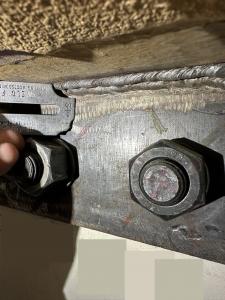Welding Inspection Racine: Guaranteeing Precision and Reliability in Every Weld
Welding Inspection Racine: Guaranteeing Precision and Reliability in Every Weld
Blog Article
Cutting-edge Approaches to Fillet Weld Evaluation and Screening: Enhancing Weld Top Quality and Conformity Criteria
In the world of welding, the high quality and stability of fillet welds play a vital role in making certain the architectural soundness and integrity of numerous commercial components. With the constant drive for improved performance and conformity with strict criteria, the exploration of innovative strategies to fillet weld assessment and testing has actually come to be crucial.
Advanced Non-Destructive Testing Techniques
Making use of advanced technologies, progressed non-destructive testing approaches play a critical duty in making sure the integrity and quality of fillet welds. These techniques, such as phased array ultrasonic screening (PAUT) and magnetic particle screening (MPT), deal comprehensive insights into the weld's inner framework without causing any type of damage to the material. PAUT, as an example, utilizes numerous ultrasonic elements to evaluate the weld from various angles, supplying a comprehensive visualization of potential problems like lack of blend or fractures.
Similarly, MPT is efficient in finding surface-breaking issues by using an electromagnetic field and iron bits to the weld area. This method is especially beneficial for determining discontinuities that may endanger the weld's strength. By utilizing these innovative non-destructive screening techniques, weld inspectors can precisely examine the quality of fillet welds, making certain compliance with market criteria and guidelines. The ability to spot problems at an early stage not only boosts weld top quality but likewise stops pricey rework or failings in architectural honesty, underlining the significance of these innovative testing techniques in welding examinations.
Robotics and Automation in Evaluation
The integration of robotics and automation has actually revolutionized the examination procedure for fillet welds, enhancing efficiency and precision in quality analysis. Robotics provide precise control and repeatability in evaluating welds, making sure consistent and trusted outcomes. Automated systems can be programmed to comply with specific assessment paths, making certain extensive coverage of welds and lowering the danger of human error.
Robot evaluation systems geared up with innovative sensors can find and measure weld functions with high precision, supplying comprehensive data for evaluation. These systems can determine flaws such as fractures, absence of combination, and porosity, making it possible for timely restorative actions to be taken. Additionally, robotics and automation enable real-time information collection and analysis, offering prompt comments to drivers and helping with fast decision-making procedures.
Moreover, using robotics and automation in fillet weld examination enhances total efficiency by reducing evaluation times and boosting inspection throughput. By enhancing the inspection procedure, producers can make certain weld high quality and conformity standards are satisfied successfully, inevitably leading to cost savings and improved product high quality.
Utilizing Artificial Knowledge for Analysis
Expert system plays a pivotal role in enhancing the effectiveness and precision of analysis in fillet weld assessment procedures. By utilizing the power of AI, assessors can improve the analysis of weld quality and compliance criteria, bring about extra specific and trustworthy results. AI formulas can swiftly refine huge amounts of data from weld examinations, discovering problems or inconsistencies that might be testing to understand the naked eye. This advanced technology allows real-time surveillance of weld high quality, permitting immediate rehabilitative activities to be taken if any type of issues are found.
Moreover, AI systems can pick up from previous examination data, continually boosting their ability to determine possible problems and deviations in fillet welds. This flexible learning ability enhances the general quality assurance process, minimizing the chance of human error and making sure that welds meet the called for requirements. By integrating fabricated knowledge into fillet weld evaluation, markets can achieve greater levels of effectiveness, uniformity, and compliance in their examination practices.
Portable Equipment for On-Site Examination
 Enhancing field evaluation performance, the fostering of mobile devices transforms on-site analysis processes for fillet welds. These devices supply versatility and benefit, allowing assessors to carry out extensive assessments in numerous areas, consisting of remote or tough settings. Mobile devices such as ultrasonic screening tools, magnetic bit examination equipment, and electronic radiography systems supply real-time information and high-resolution imaging abilities, allowing quick decision-making and prompt comments on weld quality.
Enhancing field evaluation performance, the fostering of mobile devices transforms on-site analysis processes for fillet welds. These devices supply versatility and benefit, allowing assessors to carry out extensive assessments in numerous areas, consisting of remote or tough settings. Mobile devices such as ultrasonic screening tools, magnetic bit examination equipment, and electronic radiography systems supply real-time information and high-resolution imaging abilities, allowing quick decision-making and prompt comments on weld quality.One considerable advantage of mobile tools is their capacity to streamline assessment treatments, minimizing downtime and improving total efficiency. Inspectors can quickly transfer these devices to different task sites, getting rid of the demand for transferring heavy equipment or elements to off-site facilities. Furthermore, the transportability of these tools advertises cost-effectiveness by minimizing transport expenditures and speeding up examination timelines.
Moreover, using portable devices for on-site evaluation advertises proactive quality assurance measures, as assessors can quickly recognize and address any type of possible welding problems or discrepancies. By including these innovative technologies right into on-site evaluation practices, welding experts can ensure conformity with industry criteria and enhance weld top quality, ultimately bring about improved architectural integrity and safety in various welding applications.
Assimilation of Information Management Solution
Having actually browse around here enhanced on-site evaluation processes via the use of mobile devices, the next stage involves the smooth assimilation of data management systems to further improve efficiency and data evaluation abilities in fillet weld evaluation and testing. Welding Inspection Racine. By incorporating data monitoring systems into the assessment procedure, companies can improve data collection, storage, and analysis. This integration allows for real-time monitoring of weld top quality, prompt recognition of flaws, and prompt decision-making to remedy any kind of concerns that may arise throughout the evaluation procedure
The combination of data monitoring systems enables seamless interaction between various stakeholders involved in the examination process, cultivating collaboration and boosting overall top quality control actions. Eventually, the combination of information management systems offers to my latest blog post raise the criteria of fillet weld inspection and screening, making sure conformity with sector laws and enhancing weld high quality.
Verdict
Finally, innovative methods to fillet weld assessment and screening have actually considerably improved weld quality and conformity criteria. Advanced non-destructive screening approaches, robotics, automation, artificial knowledge, mobile devices, and data management systems have actually reinvented the means weld inspections are conducted. By using these innovations, markets can guarantee that welds meet the needed high quality standards and policies, ultimately improving total performance and security in welding procedures.

By using these innovative non-destructive screening techniques, weld inspectors can properly examine the high quality of fillet welds, ensuring conformity with market requirements and policies. Portable tools such as ultrasonic screening tools, magnetic fragment examination tools, and electronic radiography systems offer real-time data and high-resolution imaging capabilities, enabling fast decision-making and prompt responses on weld high quality.
Having optimized on-site inspection procedures with the use of portable tools, the following phase entails the seamless assimilation of information management systems to additionally enhance efficiency and Source data evaluation capacities in fillet weld assessment and screening (Welding Inspection Racine). Ultimately, the integration of information administration systems offers to boost the requirements of fillet weld examination and testing, making sure compliance with sector policies and boosting weld quality
 In final thought, innovative techniques to fillet weld assessment and testing have actually considerably improved weld quality and compliance criteria.
In final thought, innovative techniques to fillet weld assessment and testing have actually considerably improved weld quality and compliance criteria.Report this page